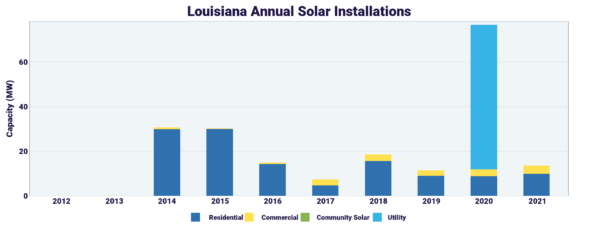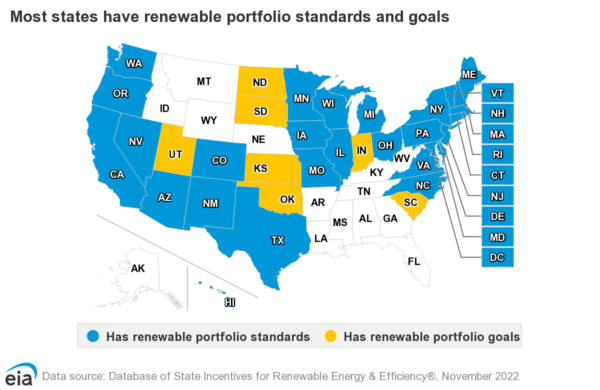The pv magazine USA tour of solar incentives last stop was Arkansas, and now moves to Louisiana. The rate of solar in “the Pelican state” is paltry at best, although major installations are about to nearly triple the current rate of 200 MW of solar installed.
Ranked 38th in the nation, according to the Solar Energy Industries Association (SEIA), Louisiana has a relatively low electricity rate, at 14.10 cents per kWh, per the U.S. Energy Information Administration (EIA), up from 11.69 a year ago. Yet the states’ per capita energy consumption is the second highest in the nation due to energy-intensive chemical, petroleum and nature gas industries, plus it has a high demand for air conditions during its hot, humid summers. Louisiana is the third highest natural gas producer in the nation, according to the EIA, and the second largest natural gas consumer on a per capita basis, after Alaska, with natural gas accounting for 65% of the state’s electricity generation.
Louisiana has lagged behind in embracing solar energy to the point where solar provides just 0.0043% of the state’s electricity, or enough to power 20,352 homes, according to SEIA. However, there are currently several large utility-scale solar projects under construction including the Ventress Solar project, which will be the largest in the state at 345 MW. The Bayou Galion Solar Project is also under construction, and it will add another 98 MW.

Louisiana’s small-scale, customer-sited solar installations are growing at a slower rate, although they account for a larger share, about three-fifths of the state’s total solar power generation, according to the EIA.
No renewable portfolio standard
Louisiana is one of only 13 states in the United States that does not have a renewable portfolio standard (RPS). In 2010, the Louisiana Public Service Commission concluded, after a renewable energy pilot program, that the state did not need an RPS. Fortunately, the state has other policies to encourage the use of renewable energy and energy efficiency, including voluntary electric utility efficiency programs, energy standards for public buildings, net metering, property tax exemption, and home energy loans.

Net metering
Louisiana allows net metering for small-scale installations of up to 25 kW for residential systems and up to 300 kW for commercial and agricultural systems. Total consumer net metering capacity connected to the grid is limited to 0.5% of each utility’s monthly retail peak power demand load, and several large electric utilities in the state have already reached their net metering cap.
In 2019 the distributed generation rules were changed in Louisiana. Those who had distributed generation installed before December 31, 2019 were grandfathered for 15 years for their current net metering billing. These customers pay the retail rate for the difference between the electricity they purchase from the utility and the electricity they supply to the grid. Those residents with distributed generation installed after Dec. 31, 2019 are billed using a crediting mechanism known as two-channel billing. Each month those customers pay the applicable retail rate for electricity purchase from the utility and they receive the full retail value for that which they produce and use behind the meter at their home or business. Any surplus energy is credited on the customer’s bill at the current “avoided cost” rate.
Beginning in 2020, Louisiana’s Public Service Commission cut by two-thirds the rate that utilities have to pay new net metering customers for excess electricity they put on the grid from their rooftop solar panels.
Home energy loan program
Louisiana’s Home Energy Loan Program (HELP) offers low-interest home improvement loans to improve the energy efficiency of their home and/or to install solar. Loans are up to a maximum of $12,000, and participants must go through an underwriting process.
Property tax incentive and solar rights
The State of Louisiana exempts solar energy systems from being included in property assessments. The state also enacted solar rights legislation (HB 751) in 2010 that prohibits entities from restricting a property owner from installing solar generating equipment. This can include homeowners’ associations, however some exceptions include historic districts, historic preservation areas and certain landmarks.
New Orleans’ community solar
The City of New Orleans has its own citywide community solar program. In partnership with Madison Energy Investments. a developer and operator of distributed generation assets, the city will construct a series of solar gardens, which interested residents buy into and receive a credit on their electricity bills for their share of the power produced. The City of New Orleans holds approval rights over the locations to make sure they align with the city’s underserved neighborhoods. The city is also exploring city-owned sites such as rooftops and vacant land for developing the projects. Installations are capped at 2 MW in capacity and projects must have a minimum of three, 1kW subscribers.
Landmark installations
The LA3 West Baton Rouge Solar Facility in West Baton Rouge is currently the largest operating facility in the state. At 74.5 MW, the solar power plant produces enough electricity to power nearly 8,000 homes. Developed by DEPCOM, the project became operational in 2020 and is currently owned by Helios Infrastructure. The power from the ground-mounted project is sold through a power purchase agreement to Entergy Louisiana.
Corporate users in Louisiana include Brookfield Properties Retail, Walmart and Abita Brewing, with Brookfield’s 1.3 MW Mall of Louisiana solar project representing one of the largest corporate installations in the state.
These projects will soon be dwarfed, however, by the previously mentioned Ventress solar farm, which is currently being constructed by Lightsource bp and expected to be operational in 2023. The energy it generates will be sold to McDonald’s Corporation and eBay under long-term power purchase agreements. Ampirical Solutions, headquartered in Louisiana, has been selected as the EPC for the project substation and the switchyard. The project has created approximately 400 construction jobs and will provide an estimated $30 million dollar boost to Pointe Coupee Parish over the project lifetime.
“Beyond improving the health and energy security of communities across America, large-scale solar projects help strengthen local economies. As the owner and operator of the Ventress solar farm, we look forward to bringing economic benefits to Pointe Coupee Parish, along with fostering long-term community partnerships,” said Kevin Smith, CEO of the Americas, Lightsource bp.
Up next
The next stop on the pv magazine USA tour of solar incentives will be Texas.
This content is protected by copyright and may not be reused. If you want to cooperate with us and would like to reuse some of our content, please contact: editors@pv-magazine.com.









By submitting this form you agree to pv magazine using your data for the purposes of publishing your comment.
Your personal data will only be disclosed or otherwise transmitted to third parties for the purposes of spam filtering or if this is necessary for technical maintenance of the website. Any other transfer to third parties will not take place unless this is justified on the basis of applicable data protection regulations or if pv magazine is legally obliged to do so.
You may revoke this consent at any time with effect for the future, in which case your personal data will be deleted immediately. Otherwise, your data will be deleted if pv magazine has processed your request or the purpose of data storage is fulfilled.
Further information on data privacy can be found in our Data Protection Policy.